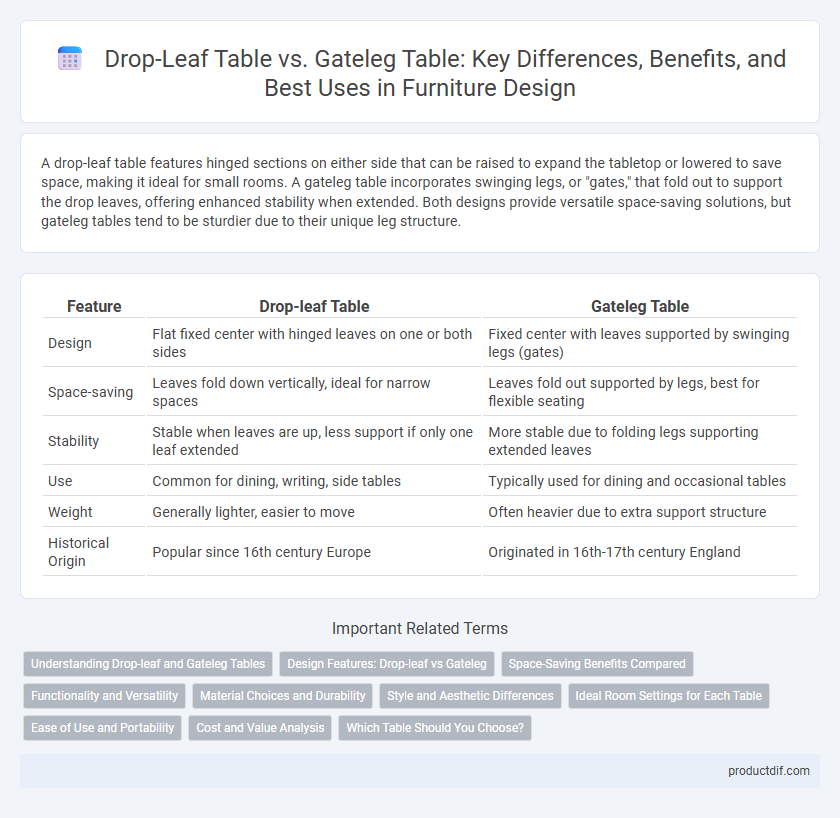A drop-leaf table features hinged sections on either side that can be raised to expand the tabletop or lowered to save space, making it ideal for small rooms. A gateleg table incorporates swinging legs, or "gates," that fold out to support the drop leaves, offering enhanced stability when extended. Both designs provide versatile space-saving solutions, but gateleg tables tend to be sturdier due to their unique leg structure.
Table of Comparison
| Feature | Drop-leaf Table | Gateleg Table |
|---|---|---|
| Design | Flat fixed center with hinged leaves on one or both sides | Fixed center with leaves supported by swinging legs (gates) |
| Space-saving | Leaves fold down vertically, ideal for narrow spaces | Leaves fold out supported by legs, best for flexible seating |
| Stability | Stable when leaves are up, less support if only one leaf extended | More stable due to folding legs supporting extended leaves |
| Use | Common for dining, writing, side tables | Typically used for dining and occasional tables |
| Weight | Generally lighter, easier to move | Often heavier due to extra support structure |
| Historical Origin | Popular since 16th century Europe | Originated in 16th-17th century England |
Understanding Drop-leaf and Gateleg Tables
Drop-leaf tables feature hinged leaves on one or both sides that fold down to save space, making them ideal for smaller rooms or occasional use. Gateleg tables include swinging legs, or "gates," which swing out to support the drop leaves when extended, providing extra stability and a classic design element. Both table types maximize functionality by allowing easy adjustment of table size, accommodating varying numbers of users.
Design Features: Drop-leaf vs Gateleg
Drop-leaf tables feature hinged leaves that fold down vertically, offering a compact design ideal for small spaces and easy expansion when needed. Gateleg tables have swing-out legs that support the leaves, providing increased stability and a classic look with their distinctive leg frames. Both styles optimize space but differ in their support mechanisms and overall aesthetic appeal.
Space-Saving Benefits Compared
Drop-leaf tables feature hinged leaves that fold down vertically, making them ideal for compact spaces by reducing surface area when not in use. Gateleg tables have legs that swing out to support the extended leaves, providing greater stability and flexible seating options while folding neatly to save space. Both designs optimize room efficiency, but gateleg tables generally offer enhanced support and versatility in narrower areas.
Functionality and Versatility
Drop-leaf tables feature hinged sections that can be folded down to save space or extended to create a larger surface area, offering flexible functionality ideal for small or multifunctional rooms. Gateleg tables utilize hinged legs that swing out to support the drop leaves, providing enhanced stability and versatility for dining or workspace needs. Both designs maximize space efficiency while adapting easily to varying user requirements, making them practical choices for dynamic living environments.
Material Choices and Durability
Drop-leaf tables commonly feature hardwoods like oak and maple for enhanced durability, while gateleg tables often incorporate sturdy materials such as teak and walnut to withstand frequent folding mechanisms. Both table types benefit from solid wood construction, which provides resistance to warping and ensures longevity. Surface finishes like varnish or lacquer additionally protect these tables from moisture and daily wear, maintaining their structural integrity over time.
Style and Aesthetic Differences
Drop-leaf tables feature hinged sections that fold down vertically to save space, lending a minimalist and versatile style ideal for modern or transitional interiors. Gateleg tables incorporate swinging legs that support the extended leaves, evoking a classic, rustic charm often associated with traditional or farmhouse aesthetics. The gateleg's robust, visible leg structure contrasts with the streamlined silhouette of drop-leaf tables, influencing room ambiance and furniture harmony distinctly.
Ideal Room Settings for Each Table
Drop-leaf tables are ideal for small to medium rooms, offering flexibility in spaces like kitchens or dining areas where occasional extra surface area is needed without sacrificing floor space. Gateleg tables suit larger rooms or multipurpose spaces, as their swing-out legs provide sturdy support for extended surfaces, making them perfect for formal dining rooms or spacious living areas. Both table types excel in maximizing space efficiency while enhancing room functionality tailored to specific layout requirements.
Ease of Use and Portability
Drop-leaf tables feature hinged sections that fold down vertically, making them quick to expand or collapse and ideal for spaces requiring flexible surface area. Gateleg tables incorporate swinging legs that support the leaves, providing stability but often requiring more effort and space to adjust. The drop-leaf design generally offers superior ease of use and portability due to its simpler mechanism and lighter construction.
Cost and Value Analysis
Drop-leaf tables generally cost less than gateleg tables due to simpler hinge mechanisms and fewer materials required in manufacturing. Gateleg tables offer greater value through enhanced stability and expanded surface area when extended, justifying a higher price point for users needing versatile, durable furniture. Cost-wise, drop-leaf tables suit budget-conscious consumers, while gateleg tables provide long-term utility and investment for space optimization.
Which Table Should You Choose?
Drop-leaf tables provide versatile surface area by folding one or both leaves down, ideal for compact spaces and occasional use. Gateleg tables feature hinged legs that swing out to support extended leaves, offering greater stability for larger gatherings. Choose a drop-leaf table for easy storage and flexibility, while gateleg tables suit those needing robust support and traditional style.
Drop-leaf Table vs Gateleg Table Infographic

 productdif.com
productdif.com